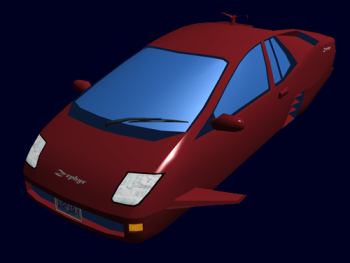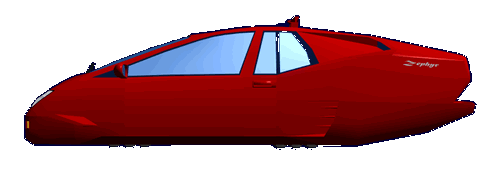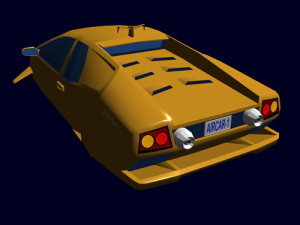Sidebar
Table of Contents
EM-K4 "Zephyr" Air Car
The EM-K4 “Zephyr”1) Air Car is a high-performance anti-gravity atmospheric vehicle built for the civilian customer. It became available in YE 33.
About the EM-K4
The EM-K4 Zephyr is Emrys Industries return to vehicle production. It is their solution to traffic gridlocks. Why limit the customer to having to use roads; when there is so much air above. The EM-K4 is very simple to operate, in fact with the exception of altitude it controls exactly like a car. It is designed to handle well in traffic, as well as above. The EM-K4 features a host of safety features such as airbags, anti-collision, auto-pilot, passive and active restraints. Emrys Industries feels the EM-K4 is the safest high-performance anti-grav vehicle. It has a storage compartment in the nose, and a state of the art security system. The Zephyr has seating for four including the driver.
Appearance
The EM-K4 Zephyr is a streamlined tapered body. It has standard vehicle lights on the front and rear. Underneath there are four synchronized anti-gravity modules. Protruding from the rear are two electric turbo-fan engines for high speed travel. A satellite antenna for radio and navigation can be seen on the top. The handles for opening the gull-wing doors can be seen on either site. Protruding from the nose of the car on either side are control canards. The Zephyr is available in a wide range of colors.
Operation
The Zephyr operates in three modes, each have specific criteria, and possible speeds.
| Mode | Altitude | Details |
|---|---|---|
| Ground | .3 - 1m | In this mode the vehicle performs like a ground car. |
| Altitude | 1 - 300 m (3.28 - 984 ft) | In this mode the operator can now control elevation. While in mode the ETJE is disabled, normally for use within a city limits or short distance trips out or into the city. Dropping to 1 meter will cause the vehicle to enter Ground mode. Going above 300m enables Speed mode but does not automatically switch to it. |
| High Speed | 300 - 6,096 m (1000 ft - 20,000 ft) | In this mode the operator can control elevation and the ETJE is available for high speed travel. Normally this mode is used for long distance travel. Dropping below 300m will cause vehicle to enter Sky mode. |
Note: The EM-K4 series is limited to a max alt of 6,096m or 20,000 ft. Note: The Canards only operate when in Altitude or High Speed modes.
Specifications
Details
Manufacturer: Emrys Industries Nomenclature: Em-K4-1a \ Em-K4-2a Organizations Using This Product: Civilian Consumers & Law Enforcement Type: Anti-grav Class: Car Designer: Emrys Industries R&D section. Prices:
Dimensions
Length: 4.93m 16.2ft Height: 1.4m 4.59 ft Width: (Overall) 2.4m 7.87ft Width: (Body) 1.8m 5.9ft Load: 730 kg (1,600 lbs)
Speeds
See specific model for details.
Damage Capacity
See Damage Rating (Version 3) for an explanation of the damage system.
- Body: 7 SP (Armor)
Inside the Em-K4
Entry to the cabin is through the gull-wing pneumatic doors. The cabin of the EM-K4 contains four seats. The driver sits in the left front seat.
Em-K4 Systems
EM-K4-A3300
The EM-K4 is built to protect the occupants; the car's frame is composed of Osmiridium. While the body panels are fashioned out of Durandium Alloy.
EM-K4-E3300 Control System
The EM-K4 primary control system consists of a steering wheel, an accelerator, a brake, a direction control, and a mode selector. The instrumentation is mounted in the dashboard, and can be projected on the forward windshield like a heads up display. The customer can select a variety of information to be displayed.
| Control | Function |
|---|---|
| Steering Wheel | The Steering wheel is used to control the heading of the car. In ground mode the steering wheel does not move in or out. In the other two modes, pulling the wheel towards the operator causes the car to rise. Pushing the wheel forward causes the vehicle to lower. |
| Accelerator | This controls the speed of the vehicle just as with regular cars. |
| Brake | This control works the opposite of the accelerator, using the anti-grav system to stop the vehicle. |
| Direction Control | This controls if the vehicle is going to move forward, reverse or hover. |
| Mode Selector | This consists of three illuminated buttons that select the vehicle operating mode. |
EM-K4-E3301 Autopilot Collision Avoidance System
The Autopilot Collision Avoidance System or ACAS is the heart of the Zephyr and ensures the safety of the occupants. The ACAS controls and monitors all aspects of the vehicle. The ACAS has two other modes of operation, autopilot and collision avoidance. The autopilot is always operational, when not specifically driving the vehicle it operates as the Anti-Collision system. It is a limited Artificial Intelligence; it also stores the occupant's biometric preferences, adjusting the seat, steering wheel to preferred positions. It also loads the driver's communicator data and frequent destinations.
ACAS is interactive; it responds to verbal commands, and control pad ones. It is typically programmed with a personality akin to a chauffeur.
Autopilot Mode
The ACPAS in autopilot is capable of driving the vehicle to its destination in all operating modes. It uses GPS data, and mapping data from the planetary records. In a large metropolis the ACAS will interface with the traffic control system. When driving in ground mode the ACAS will obey the traffic laws, and take the most efficient path unless otherwise instructed. For longer distance travel, the ACAS plots its course taking into account of restricted airspace, obstacles and so for. It will also inquire if the occupant wants to use the ETJE.
Collision Avoidance Mode
The ACAS is always operating even when the driver is in control. If the vehicle is going to impact an object, it will automatically take corrective action. This includes vehicles on the sides. The ACAS will also control the descent of the Zephyr. If the Zephyr is descending too fast it will override the operator.
EM-K4-E3302 Communications
The Zephyr has the following systems, Global Positioning System, Satellite Radio, Telecommunications, and electronic data transmission. The car has stereo speakers, and each passenger position has a jack for personal headsets. Telecom can be synced to the owner's personal communicator, or it can be performed via public network.
EM-K4-E3303 Sensors
The Zephyr is equipped with a number of sensors to assist the operator and the autopilot. These are the sensors the car is equipped with.
| Sensor | Coverage | Purpose |
|---|---|---|
| Radar | 360° | Weather radar, ground mapping and object avoidance |
| Sonar | 360° | Object detection in ground mode |
| Radar Altimeter | Below | Determining height above ground |
| Visual | 360° and below | Object identification and tracking |
| Digital Barometric Altimeter | N/A | Determine altitude relative to sea level |
EM-K4-V3300 Environmental System
The EM-K4 supplies temperature controlled filtered air to the cabin for the passenger's comfort. At an altitude of 3,048m (10,000ft) or higher the cabin is pressurized to 1 ATM. The V3300 supplies temperature control four each seat position.
Power
EM-K4-G3300 Fusion Generator
The EM-K4-G3300 is a compact hydrogen fusion reactor, generator, and cooling system. Fuel for the Generator is stored in a refillable container at any hydrogen distributor.
The fuel module has enough fuel for the reactor to run for 360 hours.
EM-K4-G3301 Fuel Cell
The EM-K4 has an emergency power supply in the form of a high-efficiency hydrogen fuel cell. This is used to supply power to start the reactor or provide power in the event the generator has failed.
Propulsion
EM-K4-P3300 Anti-Gravity Units
The EM-K4 is equipped with four paired anti-gravity generator arrays. Each array consists of four anti-gravity generators. This provides a measure of redundancy in the array and allows the array to make micro adjustments as needed.
Each pair of are synchronized with the other units. In each pair one generator array is dedicated to lift, and the other to propulsion. In the event of damage or failure of the life array the propulsion array will switch to lift.
EM-K4-P3301 Electric Turbofan Jet Engine
The Electric Turbofan Jet Engines (ETJE) are designed to provide extra propulsion for high speed travel. They are powered by the car's generator. Air is drawn into the turbines via the ducts in the sides of the car and forced out through the nozzles in the rear of the car. There is no combustion so the ETJE does not have hot exhaust.
Note: The control system will not allow the ETJE to operate below 300 meters, or within a municipality’s traffic grid. Note: The ETJE will not operate in a vacuum as there are fail-safes to keep it from turning on.
EM-K4-M3300 Safety Features
Emrys Industries wanted the EM-K4 to be the safest they could make it. It includes the following features.
Collision Avoidance
The Zephyr will sound a warning and automatically reduce speed if it detects an imminent collision. This is also true if the rate of descent is to fast; the Zephyr will adjust the ROD to allow the vehicle to safely reach the surface. See the ACAS.
Physical Restraints
The EM-K4 is equipped with restraint belts for the occupant's safety. They consist of two crossing shoulder belts, and a lap belt.
Gel bags
The EM-K4 is equipped with a number of emergency gel bags. In the event of an imminent high force impact, the ACAS will deploy the gel bags. The bags fill with a rapid expanding gel that absorbs kinetic energy. Bags are in place to secure the occupants legs, torso, and there are sign panel bags to prevent the occupants hitting the side of the vehicle. Five seconds after the vehicle has come to a stop a reagent is injected to the bags causing the gel to collapse.
Parachute
In the event of a total failure of the power or anti-grav system, the Zephyr will deploy a cargo parachute and float down safely.
EM-K4-M3301 Landing Gears
The Zephyr has four retracting pneumatic landing skids. They extend when speed drops to <10 kpm and altitude is less than 1 meter. At faster speeds or higher altitudes the landing gear retract.
EM-K4-M3302 Security
The Zephyr has a number of restricting access. Each of the door handles has a biometric keypad which can check the four fingerprints at one time. The keypad can be used to enter a security code. Visual recognition, the cameras can scan the person and visually confirm identity. Lastly the EM-K4-1a can be accessed by using a synced EM-G8 Type 33 Datapad.
| Products & Items Database | |
|---|---|
| Product Categories | vehicles |
| Product Name | "Zephyr" Air Car |
| Nomenclature | Em-K4 |
| Manufacturer | Emrys Industries |
Page Tools
Terms of Service - Privacy Policy





